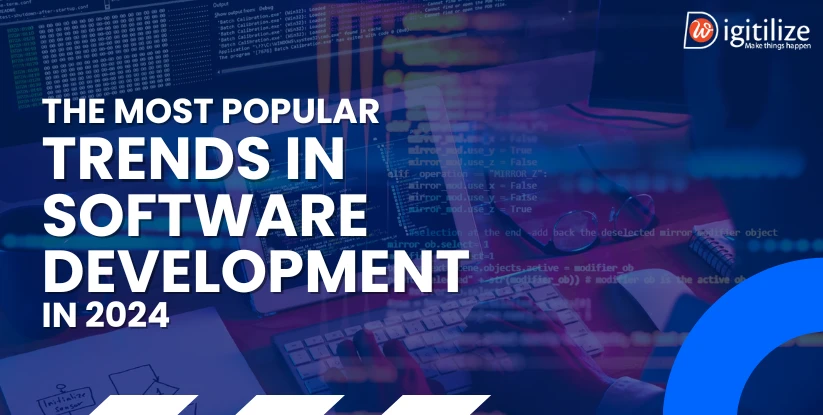The Most Popular Trends in Software Development In 2024

Now that 2024 has arrived, it is clear that although certain technologies will continue to advance, others will also emerge. Social demands and technological advancements are likely to drive many of the changes we will witness. So, it is important to be aware of the most popular trends in software development in 2024.
We’ll talk about how user experience will be impacted by this new global software development environment. Observe how best practices are changing to satisfy the ever-changing expectations of consumers. It takes note of any opportunities that may arise for entrepreneurs wishing to break into this industry.
So, we shall elucidate the current software industry developments in this article. Let’s examine the most recent developments in software development in 2024!
Top trends of software development in 2024
-
Cloud-based computing
-
Using Low-Code Development to Optimise Costs
-
Large Language Models’ Effect on Software Development

Large Language Models, or LLMs, are artificial intelligence systems that are employs in ML and NLP. Applying patterns and facts, LLMs generate and understand text like people do after learning from enormous amounts of textual data. Software development is evolving because of LLMs such as GPT 4, LlaMA, and BERT models. Using low-code and no-code tools, these LLMs facilitate software creation for non-developers.
Software architects utilise these LLM models to evaluate systems, spot issues, and reach better choices. Because of their sophisticated nature, these LLMs facilitate the creation of comprehensible documentation by elucidating code and making it available to developers.
-
The Big Data Sector Continues to Advance
-
Python Is Superior to JavaScript
Python’s simplicity and capacity to accommodate many programming paradigms may be the reason for the machine learning explosion in the developer community. So, python offers many options for online. Also desktop app development to organise system processes since it has a big library of software that can be inserted into a code and grown into massive apps.
-
Blockchain Technology
-
5G infrastructure
-
PWAs, or progressive web apps
-
Software Quality is Driven by QA Automation
-
The Fintech Movement Continues
-
Code Reviews That Are Automated
As a result, one of the hottest new trends in software engineering is automate code reviews. These tools compare the software’s code with a set of guidelines and best practices. CodeClimate, DeepSource, and Codacy are a few of the popular automate code review programmes. This is one of the software development concepts that is now garnering the greatest traction.
-
Dispersed Infrastructure

An architecture as a distributed infrastructure makes use of a distributes strategy to store and process data across several data centers. Some of which may be geographically separated from one another. Highlighting the necessity of software development expertise to provide the best cloud-native development, it will democratize IT infrastructure.
In the past, scaling your application was challenging as you had to boost your processing power. It makes sure that each component meets all of its specifications. Since the company won’t have to pay overhead or other expenses, distributed infrastructure will eventually result in cheaper development costs. So, broad infrastructure lowers latency and enhances accessibility for businesses accessing data from remote. Mobile devices that are secure in remote locations.
-
Changing Out the Legacy Systems
We segregate and confine insecure programs and code blocks within virtual cages until we implement further security measures. This complicates matters and undermines the initial goal of achieving straightforward control over software development methods and outcomes.
Remaining competitive in this tech-driven world is a constant struggle for organisations. The software development sector is always changing, and although certain trends could be waning. Others will only get bigger. to stay current with the most recent developments in software development. The best technology should be integrated into your company by employing a UK App developer. If you’re still unsure about which technology is appropriate for you, DigitilizeWeb is a reliable resource for hiring app developers. They will provide you with the optimal solution after assessing your business needs. You can get in touch with our professionals if you have any further questions! For more follow us onLinkedIn.
FAQ
Frequently Asked Questions
UI/UX design trends evolve with changing user preferences and technological capabilities. In 2024, we might see a greater emphasis on immersive experiences, accessibility, and personalization in software applications, driven by advancements in technologies like augmented reality (AR) and machine learning.
Regulatory changes, particularly in areas like data privacy (e.g., GDPR, CCPA) and cybersecurity, can influence how software applications are developed and maintained. In 2024, developers will need to stay updated on relevant regulations and ensure compliance in their software solutions.
Low-code and no-code development platforms empower users with varying levels of technical expertise to build software applications rapidly. In 2024, we might see continued growth in these platforms, with enhancements in capabilities, integration with AI technologies, and support for more complex use cases.
IoT ecosystems are expanding, creating opportunities and challenges for software developers. In 2024, we might see advancements in IoT development frameworks, edge computing solutions, and standards for interoperability and security in IoT devices and applications.
Architectural paradigms like microservices, serverless, and event-driven architecture have been gaining traction in recent years. In 2024, these paradigms are likely to continue evolving, with a focus on scalability, resilience, and efficiency.
DevOps practices will likely continue to evolve, with a greater emphasis on automation, observability, and collaboration between development and operations teams. Technologies like GitOps and Continuous Everything (CI/CD/CT) will play a crucial role in streamlining software delivery pipelines.

